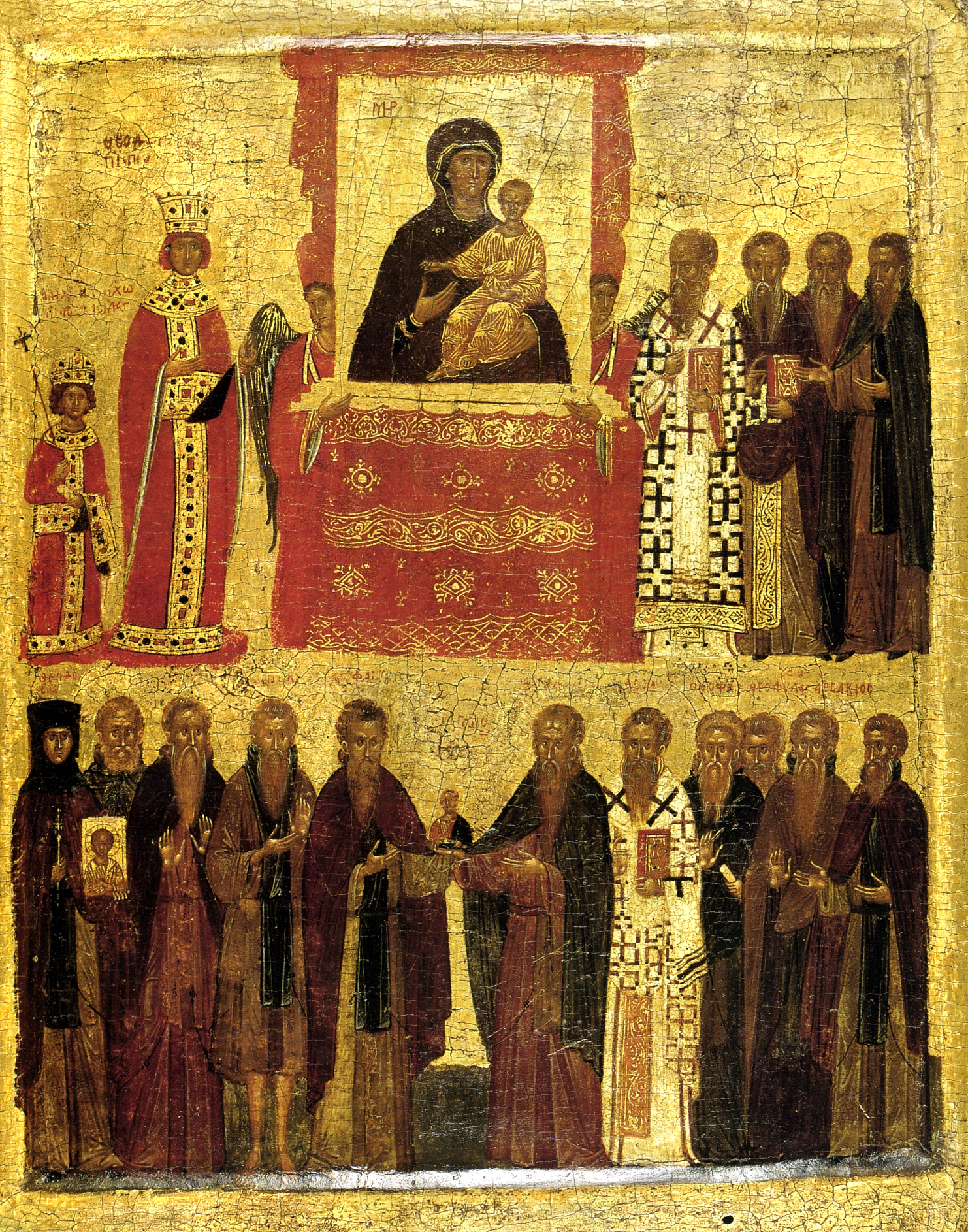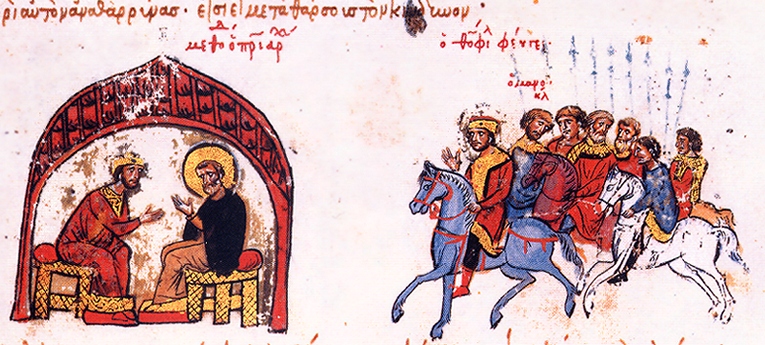|
Metrophanes Of Smyrna
Metrophanes of Smyrna was a Christian bishop, Metropolitan of Smyrna, in the ninth century. He was a leader of the Ignatian (opposed to Photius) bishops at the time of the Photian schism (867). Life In 857, when Ignatius was deposed, Metrophanes was already Metropolitan of Smyrna. He was strongly opposed to Photius. For a short time he wavered, as Photius promised not to attack Ignatius' rights, but, as soon as he found how little the intruder kept his word, he went back to his former attitude, from which nothing could make him waver again. Metrophanes was the leader of the bishops who excommunicated Photius in 858; they declared themselves excommunicate if ever they recognized him. He was chained and imprisoned, then sent into exile by the Government. After 867, Metrophanes came back to his see. He was present at the Fourth Council of Constantinople in 869, opened the sixth session with a speech and was one of the judges who condemned Photius. When Ignatius died in 877 and Phot ... [...More Info...] [...Related Items...] OR: [Wikipedia] [Google] [Baidu] |
Metropolitan Of Smyrna
The Metropolis of Smyrna () is an ecclesiastical territory (diocese) of the Ecumenical Patriarchate of Constantinople, modern Turkey. The Christian community of Smyrna was one of the Seven Churches of Asia, mentioned by Apostle John in the Book of Revelation. It was initially an archbishopric, but was promoted to a metropolis during the 9th century. Although the local Christian element was reduced during the 14th and 15th centuries, it retained its ecclesiastical autonomy continuously until 1922. History Early Christianity and Byzantine era The precise year when Christianity spread in Smyrna is unknown. It was perhaps introduced by Apostle Paul or one of his companions.Ascough, 2005: 8 By the end of the 1st century the city already hosted a small Christian community, while its first head was one named Aristion. The Church of Smyrna was also one of the Seven Churches of Asia, mentioned at the New Testament, Book of Revelation, written by John of Patmos. In ca. 110 AD, Ignatius o ... [...More Info...] [...Related Items...] OR: [Wikipedia] [Google] [Baidu] |
Iconoclasm
Iconoclasm ()From . ''Iconoclasm'' may also be considered as a back-formation from ''iconoclast'' (Greek: εἰκοκλάστης). The corresponding Greek word for iconoclasm is εἰκονοκλασία, ''eikonoklasia''. is the social belief in the importance of the destruction of icons and other images or monuments, most frequently for religious or political reasons. People who engage in or support iconoclasm are called iconoclasts, a term that has come to be figuratively applied to any individual who challenges "cherished beliefs or venerated institutions on the grounds that they are erroneous or pernicious." Conversely, one who reveres or venerates religious images is called (by iconoclasts) an ''Iconolatry, iconolater''; in a Byzantine context, such a person is called an ''iconodule'' or ''iconophile.'' Iconoclasm does not generally encompass the destruction of the images of a specific ruler after their death or overthrow, a practice better known as ''damnatio memoriae'' ... [...More Info...] [...Related Items...] OR: [Wikipedia] [Google] [Baidu] |
Joseph Hergenröther
Joseph Hergenröther (15 September 1824 – 3 October 1890) was a German Church historian and canonist, and the first Cardinal-Prefect of the Vatican Archive. Biography Born in Würzburg, he was the second son of Johann Jacob Hergenröther, professor of medicine in the University of Würzburg. In 1842 Hergenröther completed with notable success his gymnasium course in his native town, and entered the University of Würzburg to take up a two-year course of philosophical studies, to which he added certain branches of theology. His historical tendencies exhibited themselves at this early age in a dramatic poem entitled ''Papst Gregor VII'' (Würzburg, 1841). Bishop von Stahl took an interest in him, and in 1844 sent him to the Collegium Germanicum et Hungaricum at Rome, whither he had already sent Heinrich Joseph Dominicus Denzinger and Franz Hettinger. Among his scholarly teachers were Giovanni Perrone and Carlo Passaglia in doctrinal theology, Tomei in moral theology, A ... [...More Info...] [...Related Items...] OR: [Wikipedia] [Google] [Baidu] |
Trinity
The Trinity (, from 'threefold') is the Christian doctrine concerning the nature of God, which defines one God existing in three, , consubstantial divine persons: God the Father, God the Son (Jesus Christ) and God the Holy Spirit, three distinct persons ('' hypostases'') sharing one essence/substance/nature ('' homoousion''). As the Fourth Lateran Council declared, it is the Father who s, the Son who is , and the Holy Spirit who proceeds. In this context, one essence/nature defines God is, while the three persons define God is. This expresses at once their distinction and their indissoluble unity. Thus, the entire process of creation and grace is viewed as a single shared action of the three divine persons, in which each person manifests the attributes unique to them in the Trinity, thereby proving that everything comes "from the Father", "through the Son", and "in the Holy Spirit". This doctrine is called Trinitarianism, and its adherents are called Trinitarians, ... [...More Info...] [...Related Items...] OR: [Wikipedia] [Google] [Baidu] |
Anacreontics
Anacreontics are verses in a metre used by the Greek poet Anacreon in his poems dealing with love and wine. His later Greek imitators (whose surviving poems are known as the ''Anacreontea'') took up the same themes and used the Anacreontic meter. In modern poetry, Anacreontics are short lyrical pieces that keep the Anacreontic subject matter but not the metre. The Greek meter image:P.Oxy. II 220.jpg, A section from an ancient metrical treatise concerning the ''anacreonteus''. Above the description the lengths of all but the first syllable can be seen marked out; the final syllable is marked as anceps. Near the beginning of the description it is reported that some call the ''anacreonteus'' "Parionic" (παριωνικόν) because of its resemblance to the "class of Ionic meters" (Ἰωνικῶν γένους). ( P.Oxy. II 220 col. vii, 1st or 2nd century CE). The Anacreontic verse or anacreonteus is the eight-syllable line u u – u – u – – (where u = syllable weight, br ... [...More Info...] [...Related Items...] OR: [Wikipedia] [Google] [Baidu] |
Georgian Language
Georgian (, ) is the most widely spoken Kartvelian language, Kartvelian language family. It is the official language of Georgia (country), Georgia and the native or primary language of 88% of its population. It also serves as the literary language or lingua franca for speakers of related languages. Its speakers today amount to approximately 3.8 million. Georgian is written with its own unique Georgian scripts, alphabet, alphabetical systems of unclear origin. Georgian is most closely related to the Zan languages (Megrelian and Laz language, Laz) and more distantly to Svan language, Svan. Georgian has various dialects, with standard Georgian based on the Kartlian dialect, and all dialects are mutually intelligible. The history of Georgian spans from Early Old Georgian in the 5th century, to Modern Georgian today. Its development as a written language began with the Christianization of Georgia in the 4th century. Georgian phonology features a rich consonant system, including aspi ... [...More Info...] [...Related Items...] OR: [Wikipedia] [Google] [Baidu] |
Exegesis
Exegesis ( ; from the Ancient Greek, Greek , from , "to lead out") is a critical explanation or interpretation (philosophy), interpretation of a text. The term is traditionally applied to the interpretation of Bible, Biblical works. In modern usage, exegesis can involve critical interpretations of virtually any text, including not just religious texts but also philosophy, literature, or virtually any other genre of writing. The phrase ''Biblical exegesis'' can be used to distinguish studies of the Bible from other critical textual explanations. Textual criticism investigates the history and origins of the text, but exegesis may include the study of the historical and cultural backgrounds of the author, text, and original audience. Other analyses include classification of the type of literary genres presented in the text and analysis of grammar, grammatical and syntax, syntactical features in the text itself. Usage One who practices exegesis is called an ''exegete'' (; from Greek ... [...More Info...] [...Related Items...] OR: [Wikipedia] [Google] [Baidu] |
Polycarp Of Smyrna
Polycarp (; , ''Polýkarpos''; ; AD 69 155) was a Christian bishop of Smyrna. According to the '' Martyrdom of Polycarp'', he died a martyr, bound and burned at the stake, then stabbed when the fire failed to consume his body. Polycarp is regarded as a saint and Church Father in the Eastern Orthodox Church, the Roman Catholic Church, Oriental Orthodox Churches, Lutheranism, and Anglicanism. Both Irenaeus and Tertullian say that Polycarp had been a disciple of John the Apostle, one of Jesus's disciples. In '' On Illustrious Men'', Jerome similarly writes that Polycarp was a disciple of John the Apostle, who had ordained him as a bishop of Smyrna. Polycarp is regarded as one of three chief Apostolic Fathers, along with Clement of Rome and Ignatius of Antioch. Surviving writings and early accounts The sole surviving work attributed to him is the '' Epistle of Polycarp to the Philippians'', a mosaic of references to the Greek Scriptures, which, along with an account of '' Martyr ... [...More Info...] [...Related Items...] OR: [Wikipedia] [Google] [Baidu] |
Encomium
''Encomium'' (: ''encomia'') is a Latin word deriving from the Ancient Greek ''enkomion'' (), meaning "the praise of a person or thing." Another Latin equivalent is '' laudatio'', a speech in praise of someone or something. Originally was the song sung by the chorus at the κῶμος, or festal procession, held at the Panhellenic Games in honour of the victor, either on the day of his victory or on its anniversary. The word came afterwards to denote any song written in celebration of distinguished persons, and in later times any spoken or written panegyric whatever. ''Encomium'' also refers to several distinct aspects of rhetoric: * A general category of oratory * A method within rhetorical pedagogy * A figure of speech praising a person or thing, but occurring on a smaller scale than an entire speech * The eighth exercise in the progymnasmata series * A literary genre that included five elements: prologue, birth and upbringing, acts of the person's life, comparisons use ... [...More Info...] [...Related Items...] OR: [Wikipedia] [Google] [Baidu] |
Logothetes Tou Dromou
The (), in English usually rendered as Logothete of the Course/Drome/ or Postal Logothete, was the head of the department of the Public Post (, , or simply , ), and one of the most senior fiscal ministers (logothetes) of the Byzantine Empire. History and functions The office of the is explicitly attested for the first time in circa 762, but traces its origins to the officials supervising the Public Post in Late Antiquity. Until the late 4th century, the administration of the Roman Empire's Public Post was a responsibility of the praetorian prefectures. Due to the abuse of the Post and its privileges by the officials of the praetorian prefecture, in the late 4th century the oversight over the Post passed to the , while the day-to-day administration remained in the hands of the praetorian prefecture. As a result, an official known as the , the inspector of the Public Post, is attested in the late 4th-century ''Notitia Dignitatum'' (''Pars Orientalis'', XI.50) as one of the princ ... [...More Info...] [...Related Items...] OR: [Wikipedia] [Google] [Baidu] |
Patriarch Methodius I
Methodius I of Constantinople or ''Methodios I'' (; 788/800 – 14 June 847) was Ecumenical Patriarch of Constantinople from 11 March 843 to 14 June 847. He was born in Syracuse and died in Constantinople. His feast day is celebrated on June 14 in both the East and the West. Life Born to wealthy parents, Methodius was sent as a young man to Constantinople to continue his education and hopefully attain an appointment at court. But instead, he entered a monastery in Bithynia, eventually becoming abbot.Adrian Fortescue"Methodius I" ''Catholic Encyclopedia'', Vol. 9, New York, Robert Appleton Company, 1910 Under Emperor Leo V the Armenian (813–820) the Iconoclast persecution broke out for the second time. In 815 Methodius went to Rome, perhaps as an envoy of the deposed Patriarch Nicephorus I of Constantinople. Upon his return in 821 he was arrested and exiled as an iconodule by the Iconoclast regime of Emperor Michael II. In 828 Michael II, not long before his death, mitig ... [...More Info...] [...Related Items...] OR: [Wikipedia] [Google] [Baidu] |
Photios I Of Constantinople
Photius I of Constantinople (, ''Phōtios''; 815 – 6 February 893), also spelled ''Photius''Fr. Justin Taylor, essay "Canon Law in the Age of the Fathers" (published in Jordan Hite, T.O.R., and Daniel J. Ward, O.S.B., "Readings, Cases, Materials in Canon Law - A Textbook for Ministerial Students, Revised Edition" ollegeville, Minn., The Liturgical Press, 1990, p. 61 (), was the Ecumenical Patriarch of Constantinople from 858 to 867 and from 877 to 886. He is recognized in the Eastern Orthodox Church as Saint Photius the Great. Photius I is widely regarded as the most powerful and influential church leader of Constantinople subsequent to John Chrysostom's archbishopric around the turn of the fifth century. He is also viewed as the most important intellectual of his time – "the leading light of the ninth-century renaissance". He was a central figure in both the conversion of the Slavs to Christianity and the Photian schism, and is considered " e great systematic compiler ... [...More Info...] [...Related Items...] OR: [Wikipedia] [Google] [Baidu] |




